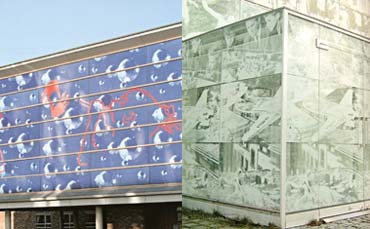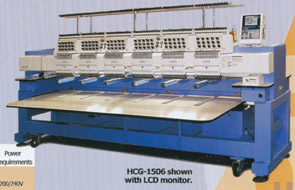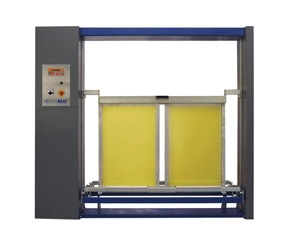A Look at Options for Decorating Flat Glass
Published
17 years agoon

Glass is just an everyday object for many of us—one that we rarely stop to consider. By nature, we are inclined to look through it rather than at it. Glass is confusing, as it is neither a liquid with a disordered collection of molecules, nor a solid that comprises a motionless formation of molecules. Glass exhibits definite characteristics of both and is typically classified as an amorphous solid.
Glass is just an everyday object for many of us—one that we rarely stop to consider. By nature, we are inclined to look through it rather than at it. Glass is confusing, as it is neither a liquid with a disordered collection of molecules, nor a solid that comprises a motionless formation of molecules. Glass exhibits definite characteristics of both and is typically classified as an amorphous solid.
A unique characteristic of glass is that it is one of the most transparent solid substances on earth. People do not realize this phenomenon, as they just look through a window, instead of observing the window glass to confirm this special characteristic.
If we take a closer look at flat glass in general, we may ascertain that people can look through the glass. Meanwhile, the glass helps maintain the climate inside the building, providing the desired comfort and protecting against undesired atmospheric influences.
Glass can easily be processed by simply modifying its surface properties or by changing its shape by way of high-temperature bending, forming, slumping, or fusing. Among other things, flat glass is an integral part of architectural objects (Figure 1), automotive components, gaming machines, appliances, and art objects. The possibilities seem endless when you consider all of these potential applications and the ways in which you can decorate the glass. Let’s examine some of the basics associated with the production of glass panels. Then, we’ll discuss some of the ways you can decorate the surface of this unique medium.
AdvertisementThe float-glass process
In 1952, Alastair Pilkington was washing the dishes when a plate moved for a short period of time across the surface of some water on a countertop. Pilkington wondered if this effect—the principle of floating—could help him produce flat glass.
He spent seven years developing the float-glass process, the idea of forming a ribbon of glass by floating the melted sand, soda ash, and limestone at temperatures approaching 3000°F over the surface of melted tin. Today, after the tin bath, the solid ribbon of glass moves roughly 400 ft through the annealing oven, allowing the glass to cool down to approximately 100°F at a steady rate. The annealing process relieves the internal stress of the glass, allowing it to be cleanly cut to the most common jumbo size of 20 x 10.5 ft and processed in a tightly controlled way. The standard size can be adjusted on request and depending on the demand. Nowadays, about 90% of the high-quality flat glass in the world is made according to the float-glass process. Sir Alastair Pilkington was awarded a knighthood in 1970 and died in 1995.
Tinting
Instead of producing clear float glass, the manufacturer can mix certain chemicals with the standard raw materials prior to melting in order to produce body-tinted glass. The final color of the tinted glass is determined by the additives selected. Tinted glass controls the heat and solar light transmission in buildings. Specific colors are added to reduce the influence of solar radiation in generating heat within buildings. Tinted glass plays an important architectural role, improving the exterior aesthetic appearance of building façades.
Finishing glass
AdvertisementFinishing glass in general causes a modification of the glass’s surface and its characteristics. Typical finishing techniques are coating, laminating, etching, and sandblasting. These glass-surface-modification techniques produce most required optical or functional characteristics.
Ultra-thin plasma- or CVD-coatings modify the absorption and reflection characteristics of glass by providing clear float glass with a microscopically thin conductive layer. The metal-oxide layers allow light transmission and permit the heat of the sun to pass through the glass into the building.
Laminated glass is manufactured by combining one or more glass panes, using one or more intermediate layers of resilient polyvinyl butyral (PVB), to create high-impact-resistant laminated glass for shop fronts, stair railings, and roof glazing. Acid etching and sandblasting are examples of batch-wise surface treatments. Both techniques create a uniform, matte surface. The surface reflection of the glass approaches that of a perfect diffuser, allowing transmission of light but giving the glass a soft, translucent appearance. Acid-etched glass is a decorative option for doors, shower screens, furniture, and decorative room dividers and separation walls.
Sandblasting means spraying sand or other abrasive media at high speed against the surface of the glass. This technique provides the glass surface with a rough appearance, although the surface will remain translucent. This surface finish is usually coarser than what can be obtained by acid etching. Areas that must remain transparent are masked off before sandblasting. Screen printing is an ideal technique for applying the mask image. The depth and the degree of translucency of the sandblasted finish depend on the type and size of abrasive media used and the force at which it is applied. Sandblasted glass is used for several applications, including doors, shower screens, furniture, and interior screens.
Glass enamels
Glass enamels are substances used to tint or decorate glass surfaces. Other names for enamels include ceramic paint, ceramic paste, and glass paint. Glass enamels play a pivotal role in the decoration of glass panels for architectural work, such as façades and spandrels, as well as furniture, automotive applications, appliance components, and objects created by visual artists. All applications require different kinds of decorative glass enamels. These enamels are available in a wide variety of colors and with a range of different functional characteristics. There are several ways to apply these glass enamels. We’ll examine some of the techniques in a moment.
AdvertisementThe application method ultimately determines the deposit thickness of the enamel on the surface of the glass. Enamels for architectural and automotive glass, for example, are formulated to adhere to the glass substrate after application. The enamels are then dried to evaporate the solvent and are finally tempered at nearly 1300°F. Enamel’s vitreous content is substantial, allowing the enamel and the glass substrate to fuse together at this temperature. Enamels commonly consist of zinc-borosilicate glass frit to adjust the melting point, a ceramic stain that lends color to the glass enamel, and glass fluxes to assist in fusing the color to the glass substrate surface during firing.
Decoration techniques
There are several ways to apply a full-surface enamel coat or an image onto a glass surface. Some of the most common approaches include spray coating, curtain coating, roller coating, inkjet printing, laser printing, and screen printing.
Handheld, automatic, high-pressure pneumatic systems are available for spray coating. An even movement of the spray system across the horizontally positioned substrate ensures a thin and even deposit. An advantage of spray coating is that it also covers uneven glass surfaces. Furthermore, the technique easily allows more than one color to be applied. Covering the edges before spraying is an effective way of preventing waste and spoiling the outermost areas of the panel. The spray-coating technique results in a wet coating thickness of 20-250 microns.
During curtain coating, a continuous coating liquid flows out of a slit and falls on the horizontally moving flat-glass substrate. The glass substrate is moved by a conveyor. A gutter collects the excess coating material, which is returned to the container for re-use. Curtain coating commonly achieves a wet coating deposit of up to 350 microns. The drawback of curtain coating is the necessity to clean the edges of the substrate after the coating has been applied.
A single roller, or a number of rollers, can be used to apply the coating to flat glass. A conveyor belt transports the glass through the machine. An impression roller, or a transport roller, supports the glass substrate at the bottom and propels the glass substrate through the machine. The coating material between the rubber-covered coating roller and the doctor roller is transferred onto the glass. The thickness of the coating on the substrate is determined by the size of the nip between the doctor roller and the coating roller.
The coating roller allows rotation in the same direction of the moving glass substrate, a process known as direct roller coating. If the coating roller rotates against the direction of the moving glass, the method is then called reverse roller coating. The doctor roller is provided with a squeegee to measure out the quantity of the coating liquid. During reverse coating, the coating roller is oriented slightly off-contact to the substrate. Reverse coating usually results in evenly distributed and smooth depositions.
Roller coating also produces significantly less waste than spray coating. This technology enables users to apply a coating on the glass surface without leaving any waste on the glass edges, so no more edge cleaning is required after the coating is applied. The coatings are relatively thick and opaque. This technique, which typically applies wet coatings that vary in thickness from approximately 10-250 microns, is an effective one for providing full surface coatings on flat glass.
Inkjet printing makes a whole host of consumables redundant. There is no need for film positives, screens, or gravure cylinders. Some prepress processes are bypassed as well, such as exposure and developing. There are no printing forms to prepare before printing, or clean and store afterwards. The printed image is simply stored digitally There are other advantages, too. Digital printing allows the operator to perform a quick and easy design change, and customized designs and images can also be created. Digital imaging today is an established print technique in graphics printing and promising one for glass decorating.
Computer-to-glass, or CTG, is an innovative digital printing technique on flat glass. A CTG system may use an inkjet printer or an electrophotographic printer, comparable to a photocopier, that deposits the ceramic substance on-to the glass substrate. These systems are supposedly suitable for both interior and exterior architecture applications, automotives, and appliances where screen printing is used. For inkjet printing, ceramic ink requires frequent stirring to prevent the system from clogging during printing. In electrophotography, the virtual image, represented by charged and uncharged areas of a photoconductive cylinder, passes through a special toner composed of ceramic frit. The toner is electrostatically attracted to the charged areas of the cylinder. Just like a photocopier, a transfer roller applies the toner to the glass substrate. Digital printing is currently an ideal method for prototyping, customized printing, or small-scale production.
Screen printing
Screen printing can be used to apply a relatively thick full-surface ceramic-paste deposit or to decorate glass with single-color or multicolored geometric designs, dots in a regular pattern, organic shapes, translucent images, full surface coats, conductive inks, four-color process graphics, and more. Screen printing large, flat panes requires the same technique, equipment, and tools used in graphics screen printing. The size of the equipment and tooling is just extended.
For instance, a screen with a print area of 6.5 x 16 ft is quite common and requires a frame with a sloped profile to control the tension of the polyester mesh. Dyed polyester mesh is only used for printing halftones and relatively fine details, as a dyed fabric minimizes light scatter during exposure.
Today, screenmaking for flat-glass decoration typically involves using an automatic coating machine to apply a direct emulsion to the mesh. The stencilmaking process is increasingly becoming filmless. For the large-sized screens, the image is transferred to the emulsion using a computer-to-screen (CTS) system, which is considerably beneficial when the printer wants to accepts one-off work. The CTS prints a positive image of a high-density black wax or ink directly onto the emulsion’s surface, preventing these parts from being exposed to UV light. Newer systems directly expose the screen using lasers or digital micro-mirror devices.
Manually operated or automatic screen-printing presses can be used to decorate glass, depending on the number and/or the size of the panes to be printed. Glass panes of different sizes require continuous adjustment of the imaging area. Many printers use masking tape to prevent the screen from depositing paste on unwanted areas of the substrate.
Rotary screen printing
Flatbed screen printing is a popular method for decorating glass. However, rotary screen-printing equipment (Figure 2) is another powerful tool that, when the job involves flat glass, can be even more versatile than a flatbed screen press. Rotary presses use a cylindrical screen, allowing for a continuous print (Figure 3). The screen always rotates in the same direction, whereas the squeegee, which is inside the screen cylinder, remains stationary. The enamel ink is fed into the wedge between the inside of the screen and the squeegee. The squeegee fills the mesh with enamel ink, shears off the excess, and transfers the enamel to the substrate. For an all-over surface coating, no image is on the screen—the screen area used for coating is fully open. Rotary screen printing requires no floodbar, which results in a substantially higher print speed. Glass is fed into the rotary screen-printing machine as continuous sheet, thereby eliminating the necessity to print individual panels.
A very innovative machine, based on the principle of sheet-fed rotary screen printing, enables glass substrates of any size to be coated or printed without the need to clean the substrate’s edges. This patented invention uses a special paste stripping roller connected to a rotary screen-printing system to prevent edge spoiling. In this system, the rotary screen has a second squeegee that removes excess paste within the screen and transfers it onto the stripping roller. A paste scraper, shaped like a trough, removes the paste from the stripping roller and collects the paste. The printing area on the rotary screen is entirely free of paste before starting the next print operation. This invention enables printing onto glass panes of different dimensions and shapes in any random order and ensures cleanly printed patterns each time.
Rotary screen printing enables manufacturers to apply water-based, or more volatile, pastes to glass. The screen cylinder is effectively closed, which minimizes unwanted evaporation and opens up options in demanding applications such as printing high volumes of solar cells, imaging ultra-thin coatings, printing pastes with electrically conductive and luminescent characteristics, and more.
Seeing the possibilities
Glass is a unique substrate worth investigating for the production of decorative elements, graphics, signage, and industrial components. It also can be an ideal vehicle for showing off your capabilities and most compelling work, whether you concentrate on screen printing or digital imaging. When you consider the numerous opportunities and applications that await, and the fact that you may already have a lot of the equipment needed for glass decoration, the potential for profit should become crystal clear.
Editor’s note: The concepts expressed in this article are detailed in the 180-page book "Printing Flat Glass," by Wim Zoomer, and were presented during the international Glasstec show in October 2006. For more information, visit http://www.technical language.eu.
About the author
Wim Zoomer is the owner of Netherlands-based Technical Language, a consulting and communication business that focuses on screen printing and other printing processes. He has written nu-merous editorials for screen-printing journals and is frequently called on to translate technical documents, manuals, books, advertisements, and other materials between English, French, German, Spanish, and Dutch. He can be reached at wimzoomer@planet.nl.
SPONSORED VIDEO
Let’s Talk About It
Creating a More Diverse and Inclusive Screen Printing Industry
LET’S TALK About It: Part 3 discusses how four screen printers have employed people with disabilities, why you should consider doing the same, the resources that are available, and more. Watch the live webinar, held August 16, moderated by Adrienne Palmer, editor-in-chief, Screen Printing magazine, with panelists Ali Banholzer, Amber Massey, Ryan Moor, and Jed Seifert. The multi-part series is hosted exclusively by ROQ.US and U.N.I.T.E Together. Let’s Talk About It: Part 1 focused on Black, female screen printers and can be watched here; Part 2 focused on the LGBTQ+ community and can be watched here.
Advertisement

Inkcups Announces New CEO and Leadership Restructure

Hope Harbor to Receive Donation from BlueCotton’s 2024 Mary Ruth King Award Recipient

Livin’ the High Life
Advertisement
Subscribe

Bulletins
Get the most important news and business ideas from Screen Printing magazine's news bulletin.
Advertisement
Most Popular
-

 Art, Ad, or Alchemy1 month ago
Art, Ad, or Alchemy1 month agoF&I Printing Is Everywhere!
-

 Case Studies1 month ago
Case Studies1 month agoHigh-Density Inks Help Specialty Printing Take Center Stage
-

 Andy MacDougall1 month ago
Andy MacDougall1 month agoFunctional and Industrial Printing is EVERYWHERE!
-

 Columns2 weeks ago
Columns2 weeks ago8 Marketing Mistakes Not to Make When Promoting Your Screen Printing Services Online
-

 Editor's Note2 weeks ago
Editor's Note2 weeks agoLivin’ the High Life
-

 Marshall Atkinson2 weeks ago
Marshall Atkinson2 weeks agoHow to Create a Winning Culture in Your Screen-Printing Business
-

 Thomas Trimingham2 months ago
Thomas Trimingham2 months ago“Magic” Marketing for Screen Printing Shops
-

 News & Trends1 month ago
News & Trends1 month agoWhat Are ZALPHAS and How Can You Serve Them in Your Print Business?











